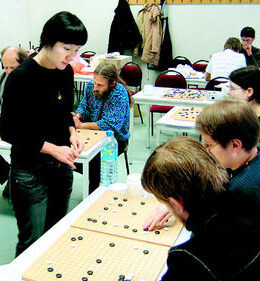hankyoreh
Links to other country sites 다른 나라 사이트 링크
‘Baduk’ players take to the world stage

Professional Baduk player Yoon Young-sun has been in Hamburg, Germany since Summer 2006 teaching the traditional game known in the West by its Japanese name, "Go." The 30-year-old has traveled to Europe every year since 2000, and in 2006 was invited by the Hamburg Go Club to stay long-term. Now, nine weeks after her arrival, she is teaching approximately 200 club members once a week.
The club found her a home, and between group classes and private lessons, she earns about 1.5 million won (US$1,580) each month, not bad considering that professional baduk players earn an average of 3 million won.
An Yeong-gil, 27, is busy struggling to learn the game’s terminology in English. Later this month, he and two associates are going to the United Kingdom to "research the baduk environment" and "study the market" there.
About his choice to relocate to the U.K., An said that "it is disconcerting to constantly have to fend off young players in Korea trying to beat me all the time. I’m going to stick to educating new players once I settle in the U.K. and quit professional baduk altogether."
An ever-increasing number of professional baduk players are leaving the country in a wave of "baduk immigration." Around ten professionals in their twenties and thirties are believed to be making similar plans, and there are even English programs designed for Koreans who want to make a living off of teaching baduk overseas. Myongji University professor Han Sang-dae says that between 70-80 students have taken a one-year "English baduk" class organized jointly by his school and Korea’s national amateur baduk association since 2005.
"I was deeply moved by the treatment baduk players receved at the 2003 amateur championship in Europe," said fourth-year Myongji University baduk major student Hong Seul-gi. "I’m thinking of taking a year off from school and teaching the game in Germany."
The reason so many baduk players are looking overseas is because of intense competition among players in Korea and a declining interest in the game among young Koreans today. Korea has more than 200 professional players but they only get about ten opportunities to show their stuff every year.
Ten years ago, there were some 2,200 baduk learning centers around the country; now, there are only 1,500. Meanwhile, the game is gathering popularity in Europe and the United States, where together there are an estimated one million players.
Since as early as the 1930s, professional Japanese players of the game have been traveling overseas to make their version better known to the outside world. As a result, most of the publications about baduk you find in Europe were written in Japan, and thus the prevalance of the Japanese term "Go" to refer to the game.
"Korean professionals have been beating the Chinese and Japanese at various international competitions over the past ten years," noted Korea Baduk Association public relations manager Yang Yeong-mo. "It’s time to contribute to the growth of baduk across the globe."
Please direct questions or comments to [englishhani@hani.co.kr]
Editorial・opinion
![[Column] Park Geun-hye déjà vu in Yoon Suk-yeol [Column] Park Geun-hye déjà vu in Yoon Suk-yeol](https://flexible.img.hani.co.kr/flexible/normal/500/300/imgdb/original/2024/0424/651713945113788.jpg) [Column] Park Geun-hye déjà vu in Yoon Suk-yeol
[Column] Park Geun-hye déjà vu in Yoon Suk-yeol![[Editorial] New weight of N. Korea’s nuclear threats makes dialogue all the more urgent [Editorial] New weight of N. Korea’s nuclear threats makes dialogue all the more urgent](https://flexible.img.hani.co.kr/flexible/normal/500/300/imgdb/original/2024/0424/7317139454662664.jpg) [Editorial] New weight of N. Korea’s nuclear threats makes dialogue all the more urgent
[Editorial] New weight of N. Korea’s nuclear threats makes dialogue all the more urgent- [Guest essay] The real reason Korea’s new right wants to dub Rhee a founding father
- [Column] ‘Choson’: Is it time we start referring to N. Korea in its own terms?
- [Editorial] Japan’s rewriting of history with Korea has gone too far
- [Column] The president’s questionable capacity for dialogue
- [Column] Are chaebol firms just pizza pies for families to divvy up as they please?
- [Column] Has Korea, too, crossed the Rubicon on China?
- [Correspondent’s column] In Japan’s alliance with US, echoes of its past alliances with UK
- [Editorial] Does Yoon think the Korean public is wrong?
Most viewed articles
- 1[Guest essay] The real reason Korea’s new right wants to dub Rhee a founding father
- 2Senior doctors cut hours, prepare to resign as government refuses to scrap medical reform plan
- 3[Column] ‘Choson’: Is it time we start referring to N. Korea in its own terms?
- 4New AI-based translation tools make their way into everyday life in Korea
- 5Opposition calls Yoon’s chief of staff appointment a ‘slap in the face’
- 6Why Korea shouldn’t welcome Japan’s newly beefed up defense cooperation with US
- 7[Editorial] Japan’s rewriting of history with Korea has gone too far
- 8Terry Anderson, AP reporter who informed world of massacre in Gwangju, dies at 76
- 9[Column] Has Korea, too, crossed the Rubicon on China?
- 10[Column] The clock is ticking for Korea’s first lady